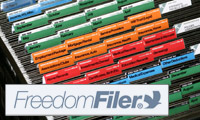A simpler way to file paid bills
I’m in Salt Lake City attending a genealogy conference. Last night I had dinner in the hotel and struck up a conversation with a woman sitting near me at the bar. Naturally, we started talking about organizing (as one does at bars) and she confessed that her biggest challenge was staying on top of the filing. I suggested that she file her paid bills by month and she found that suggestion revelatory! This morning, I thought I’d blog about it, because it had such an impact on her. A quick search revealed I’d done just that on October 24, 2011. So rather than reinvent the wheel, I decided to repeat that post. Here it is, as relevant as ever.
Do you hang on to the paper bills that your creditors send you after you pay them? (Do you even receive your bills in the mail anymore?) A certain percentage of my clients have either gone paperless or automatically shred the bills after paying.
But a larger number of clients (and my family as well) receive most of their bills in the mail and hang on to the paid bills for at least awhile. Most of those clients, at the time I meet them, are doing what I used to do: they’re filing the paid bills by payee. (All the electric bills together, all the credit-card bills together, etc.) Or, more accurately, they’re letting the paid bills pile up because it’s such a pain to file them by payee. (I used to do that, too!)
What I recommend — and I got this idea from Freedom Filer — is instead of filing paid bills by payee, file them by month paid. Freedom Filer has labels for odd year and even year months, which allows you to keep a two-year backlog. (That’s what I do.) But a one-year backlog for non-tax-related documents is almost certainly sufficient.
Here’s what you do:
- Label a dozen hanging file folders, one for each month of the year.
- Create another hanging file folder (or folders) for tax-related documents.
- When you pay bills, separate out any that can serve as documentation for a tax deduction. (This is particularly important for those of us who write off home offices.) Put those in the tax file.
- Drop the rest of the papers in the file corresponding to the month in which you’re paying them.
- After you’ve done this for a year, you’ll find the monthly file full of last year’s bills when you go to file. Simply pull out the contents and shred them. Drop the current month’s bills into the file, where they’ll stay for a year.
It’s that simple! I also put my receipts (again, non-tax-related) in the monthly files, as well as bank statements from my husband’s and my joint checking account. I’ve been doing this four about four years now and have yet to have it cause any problems. I so very rarely need to find anything in the files, but when I do it’s not difficult to find.
One note about tax-related documents: If you don’t keep track of your expenses electronically, you might want to create a series of category-related tax files to make it easier at tax time. Or just do a big sort at tax time.
This method of filing paid bills is so much less time consuming than filing by payee that the “To File” pile becomes a thing of the past. If you’re hanging on to your paid bills, I urge you to give it a try.
Tagged with: filing systems, freedom filer, paid bills, worth repeating
Comments
Links
- Institute for Challenging Disorganization
- Peace of Mind Budgeting
- National Association of Productivity and Organizing Professionals
- Organize Your Family History
- Ravelry
- Getting to Good Enough podcast
- Are you interested in becoming a professional organizer?
- Shannon Wilkinson, life coach
- NAPO St. Louis







